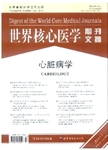心肌梗死后抑郁的预测:来自心肌梗死和抑郁干预试验(MIND-IT)的数据
Prediction of depressive disorder following myocardial infarction:Data from the Myocardial INfarction and Depression-Inter-vention Trial(MIND-IT)作者机构:Department of CardiologyThorax CentreUniversity Medical Centre GroningenP.O.Box 30.0019700 RBNetherlands
出 版 物:《世界核心医学期刊文摘(心脏病学分册)》 (Digest of the World Core Medical Journals(Cardiology))
年 卷 期:2006年第2卷第9期
页 面:36-37页
学科分类:1002[医学-临床医学] 100201[医学-内科学(含:心血管病、血液病、呼吸系病、消化系病、内分泌与代谢病、肾病、风湿病、传染病)] 10[医学]
主 题:心肌梗死后抑郁 预测因素 干预试验 多变量模型 左心室射血分数 阳性预测值 高胆固醇血症 钙通道阻断剂
摘 要:Background: Depression following myocardial infarction(MI) is associated with complicated cardiac rehabilitation, noncompliance and poor prognosis. Whether de pression following MI can be predicted from variables routinely assessed during hospitalization for MI is unknown. Methods: Using data from the Myocardial INfar ction and Depression-Intervention Trial(MIND-IT),we identified 2177 MI patient s(mean age 63 years; 23%female). Patients were randomly divided into a derivati on and a validation sample. In the derivation sample, we analyzed variables pote ntially associated with the development of post-MI depressive disorder, which w ere tested in the validation sample. Results: In the year following MI, 18.5%su ffered from depressive disorder(ICD-10 criteria). In a multivariate model, fact ors associated with depression were younger age(OR 1.94; CI 1.38-2.74), hyperch olesterolemia(OR 1.68; CI 1.08-2.61), the use of calcium channel blockers at di scharge(OR 1.80; CI 1.20-2.71), and left ventricular ejection fraction(LVEF)(OR 4.14 for patients with LVEF 30%; CI 2.42-7.10). The derived predictors were tested in the validation sample. The final model yielded two clinical predictors , i.e., younger age and severe LV-dysfunction, which correctly predicted post- discharge depression status in 82.9%of the MI patients. The model yielded a hig h negative predictive value(89%). A positive depression questionnaire(BDI) duri ng hospitalization increased the positive predictive value of 23%to 52%. Concl usions: During hospitalization for MI and using a two-step strategy with common clinical variables, i.e., younger age, severe LV-dysfunction and BDI score dur ing hospitalization, it is possible to identify MI patients with a high risk for subsequent development of depression.



